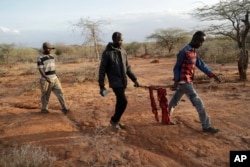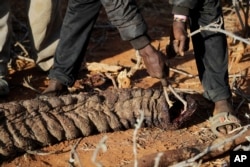Officials in Kenya say severe drought conditions in a northern area have killed hundreds of wild animals in recent months. Many animals that do survive are starving and weak. They often come in contact with people while searching for food.
Kenya’s Samburu county has experienced a lack of rain for the past four years. This has caused some of the severest dry conditions in 40 years. Experts say the effects of climate change have worsened the problem.
Officials say drought has killed at least 200 elephants, nearly 400 common zebras and more than 500 wildebeests over the past nine months. A number of other species have also been affected.
Kenya’s government has provided some emergency supplies such as water, grasses and mineral salts to help the animals. But many creatures are still found moving into areas where people live as they search for food and water.
David Lepeenoi is a 54-year-old who lives in Samburu. He told The Associated Press that elephants seem to be drawn to the trees he planted on his property. “The trees and water points are the main source of conflict between elephants and the community,” he said.
Climate change and poor conservation methods have harmed protected land areas and national parks in recent years.
“Where we have reported cases of wildlife dying, it is not actually within the parks,” said Jim Nyamu. He helps run the Elephant Neighbors Center, a nonprofit group that seeks to protect elephants and their surroundings.
Nyamu said the fact that wildlife are not dying in parks suggests they were looking for food in established areas that have been blocked by human activities.
Records from the conservation group BirdLife Africa show that many birds are also dying in northern Kenya, most likely from starvation.
The group’s Alex Ngari said the remains of migratory birds, such as the European Roller, can be seen across expanses of the very dry land. Over 300 bird species on the continent are already considered threatened or critically endangered.
The drought has also greatly harmed communities and has led to lost income, livestock deaths and failed crops. Farmers have started taking down dried trees to produce and sell charcoal to earn money.
This has added to environmental problems in the area, said Paul Gacheru, from the conservation group Nature Kenya. He told the AP an organized effort is needed to support local communities in efforts to reduce the effects of climate change. Gacheru said local people need to find less destructive ways to live with the warmer, drier climate.
In Samburu, conservation groups say they are doing what they can as natural resources dry up. At one elephant sanctuary, workers say about 30 of 40 young animals were rescued from the extreme dry conditions.
Along with the risk of starvation, drought can cause drops in immunity that can cause infections in the animals, said vet Isaiah Alolo. He works at the Reteti Elephant Sanctuary, which is part of the nearby Namunyak Wildlife Conservancy.
“In most cases, you find that the animal will die,” Alolo said. This leads to many orphaned animals that need to be rescued. “That brings a lot of pressure” for those working to conserve species, he added.
Workers at the Reteti sanctuary bring food and other nutritional products from about 50 kilometers away near Mount Kenya, sanctuary caregiver Dorothy Lowakutuk said. That area is also at risk of more environmental damage if the drought continues.
“At least we ensure our elephants are recovering what they don’t get in their natural habitat,” Lowakutuk said.
I’m Bryan Lynn.
The Associated Press reported on this story. Bryan Lynn adapted the reports for VOA Learning English.
______________________________________________________________
Words in This Story
drought – n. a long period of time during which there is very little or no rain
species – n. a group of animals or plants that are similar and can produce young animals or plants
conservation – n. an organized effort that aims to protect animals, plants and natural resources
livestock – n. farm animals (such as cows and sheep) used for grazing and roaming
sanctuary – n. a place where people or animals are given protection and shelter
immunity – n. bodily power to resist an infectious disease
orphan – n. a child whose parents are dead
habitat – n. the natural environment of a plant or animal
_______________________________________________________________
What do you think of this story? We want to hear from you. We have a new comment system. Here is how it works:
- Write your comment in the box.
- Under the box, you can see four images for social media accounts. They are for Disqus, Facebook, Twitter and Google.
- Click on one image and a box appears. Enter the login for your social media account. Or you may create one on the Disqus system. It is the blue circle with “D” on it. It is free.
Each time you return to comment on the Learning English site, you can use your account and see your comments and replies to them. Our comment policy is here.
























Discussion about this post